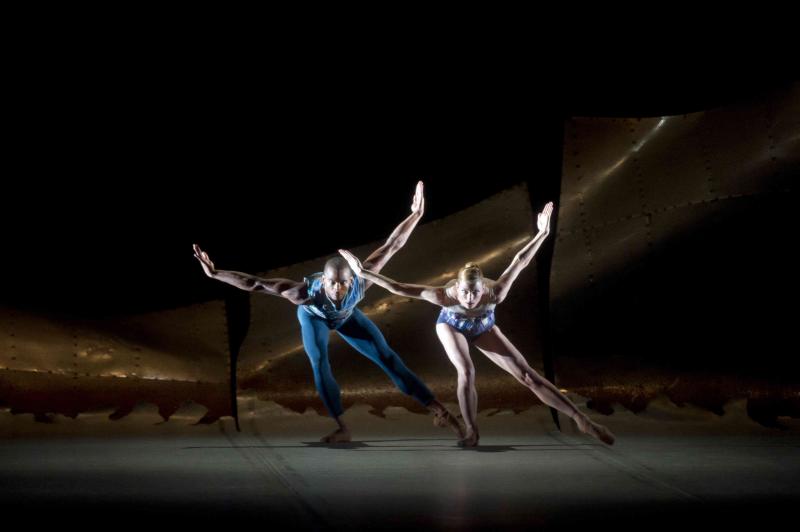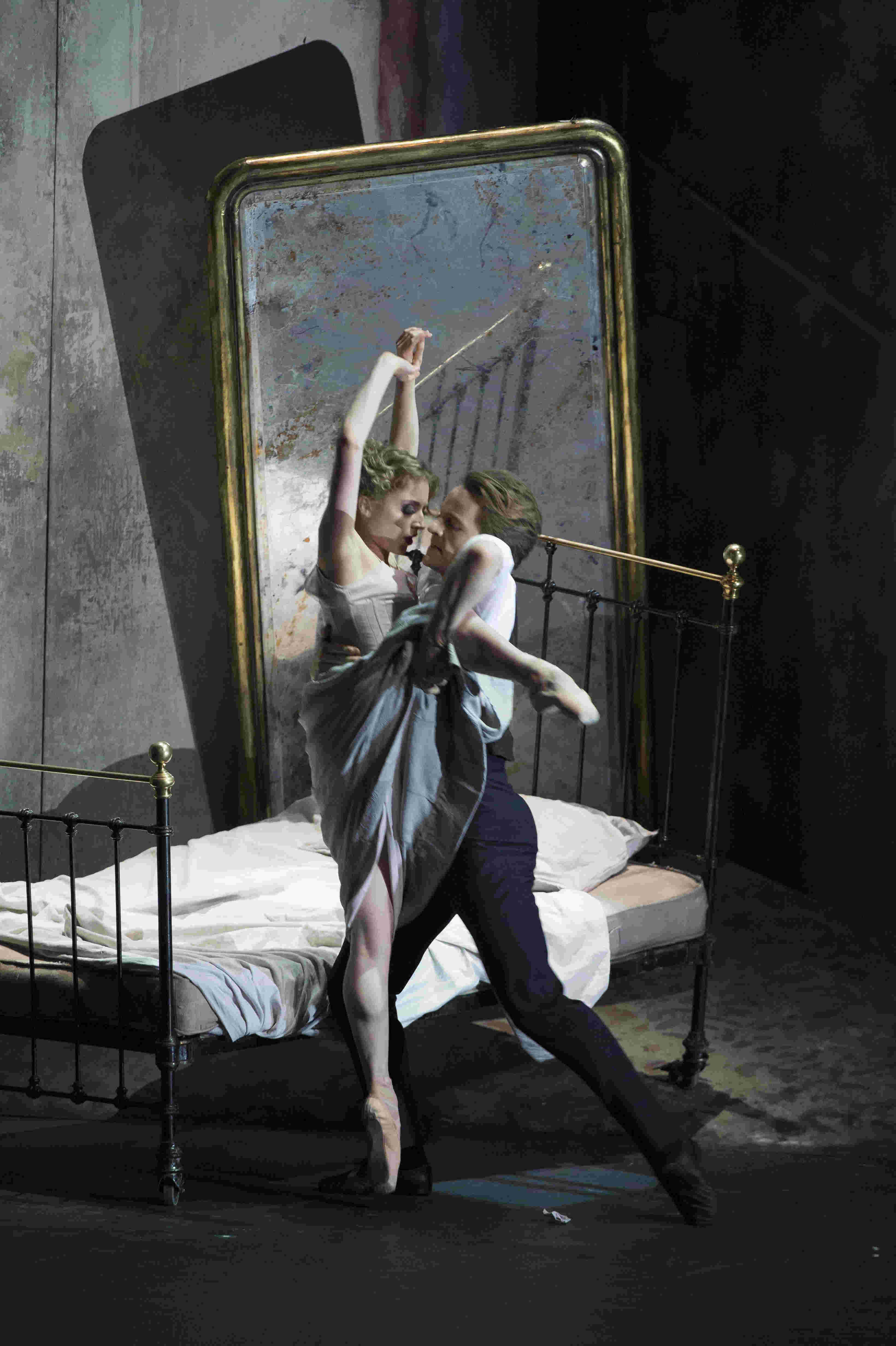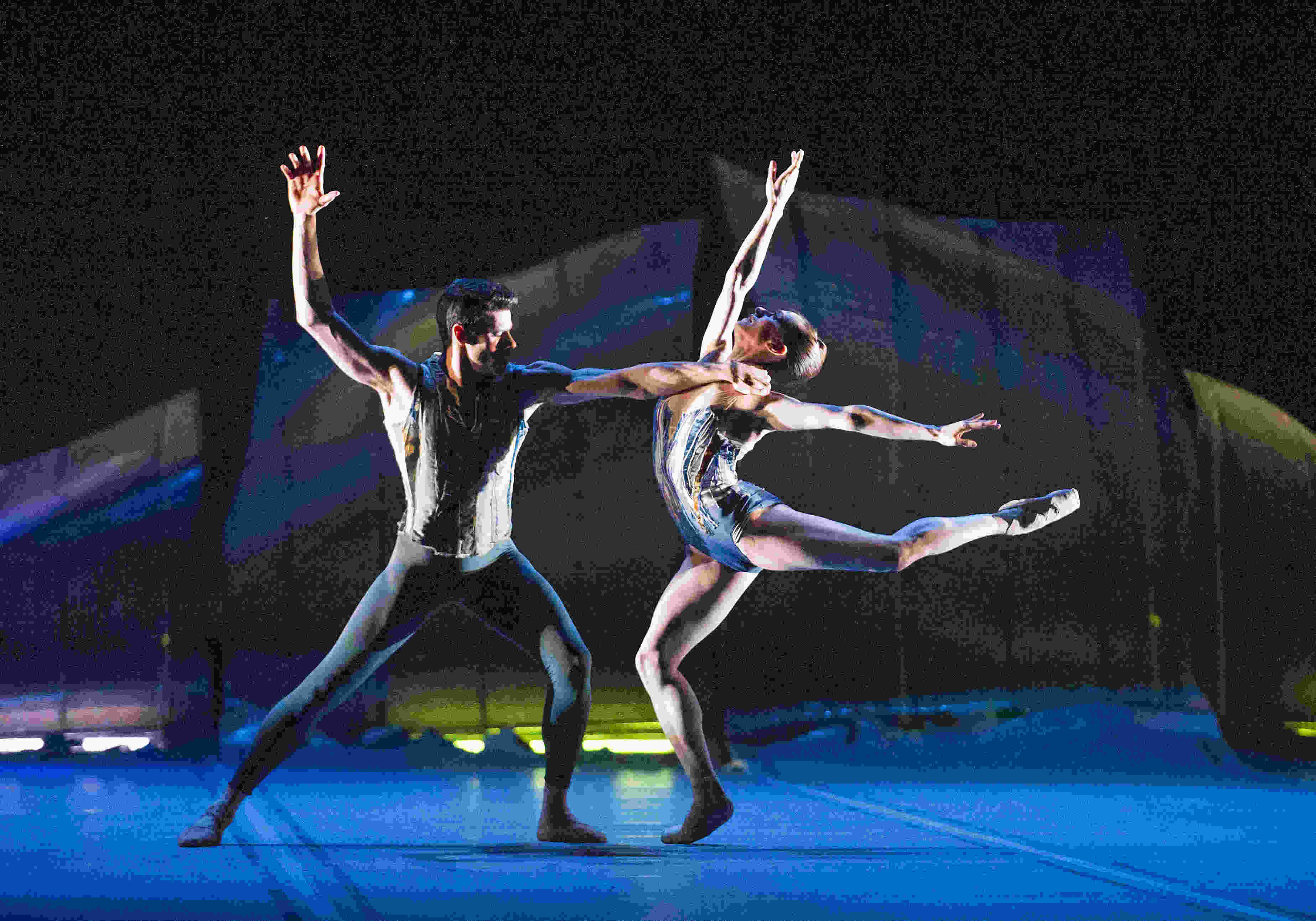Serenade/Sweet Violets/DGV, Royal Ballet | reviews, news & interviews
Serenade/Sweet Violets/DGV, Royal Ballet
Serenade/Sweet Violets/DGV, Royal Ballet
Wildly varied triple bill lurches from the sublime to the nasty

Some artists acquire (or create) cults of personality because – Byron, Wagner or Van Gogh – they are just so obviously fruity. Some others, though less fruity, are venerated because their work is so tear-prickingly astonishing that we are desperate to get closer to its source. Shakespeare is one such; George Balanchine, the twentieth-century Russian-American choreographer, is another. Serenade (1934), the first piece he made in America, is a thing of wonder.
Last night the Royal Ballet put the serene into Serenade with a very smooth performance - too smooth. This is a full-out dance, especially for the corps de ballet: it’s exciting because the dancers should be right on the edge and letting it show – everything almost too big, almost too high, almost too long. But except for Lauren Cuthbertson, who did her Russian Girl jétés with abandon, and one or two girls in the corps (Claire Calvert and Romany Pajdak struck my eye), what we saw was a gliding swan with no hint of paddling feet. Yes, the stately pace allows Balanchine’s lovely tableaux to breathe, but when Matthew Golding of the zero stage presence starts to look dashing, either he’s finally acquiring some fire, or everyone else is on ice.
 It’s a bit of both here, actually, to be fair to Golding – he had good chemistry with Marianela Nuñez's sweet Waltz Girl (both pictured left), while Melissa Hamilton was a touch cool for the Dark Angel, though gorgeous in line. I suspect the orchestra, under Pavel Sorokin, might have preferred to do Tchaikovsky with a little less serenity, too. Don’t get me wrong: these small criticisms proceed from love of both Serenade and the Royal Ballet; I’d still have happily watched them do it twice more in the same evening. Actually, that’s a thought! A triple bill of Serenades would solve the problem of what to put after such perfection, and would certainly have been better than Liam Scarlett’s Sweet Violets.
It’s a bit of both here, actually, to be fair to Golding – he had good chemistry with Marianela Nuñez's sweet Waltz Girl (both pictured left), while Melissa Hamilton was a touch cool for the Dark Angel, though gorgeous in line. I suspect the orchestra, under Pavel Sorokin, might have preferred to do Tchaikovsky with a little less serenity, too. Don’t get me wrong: these small criticisms proceed from love of both Serenade and the Royal Ballet; I’d still have happily watched them do it twice more in the same evening. Actually, that’s a thought! A triple bill of Serenades would solve the problem of what to put after such perfection, and would certainly have been better than Liam Scarlett’s Sweet Violets.
Almost anything would look cheap coming after Serenade, but Sweet Violets, here revived for the first time since its 2012 première, is worse than cheap: it’s nasty. Two years ago I gave this convoluted Victoriana slasher-ballet some credit for problematising the distinction between art and voyeurism. By consciously imitating, with his lurid dance-drama, the repulsive-yet-compulsive power of Walter Sickert’s Camden Town murder paintings, Scarlett makes the ballet audience, like Sickert’s Edwardian fans, complicit in a dangerous glamourisation of the violated female body, a complicity underlined and undermined by a clever coup de théâtre with a doubled proscenium and a mirror-image audience of leering men.
 But you can only read Sweet Violets as perched cleverly between art and voyeurism if you find its female characters and their violent demises in some way beautiful, or titillating. That’s just about possible for the few minutes of the opening pas de deux between an artist (Robert Wood) and a prostitute (Meaghan Grace Hinkis) – Scarlett’s best ideas are in this tight bedroom vignette (pictured left), whose murderous end is chilling because unexpected. But as every subsequent woman who appears in the 50-minute ballet is also hit, flung around and degraded, in choreography of ever-decreasing inventiveness, any aesthetic or voyeuristic pleasure is quickly deadened by disgust.
But you can only read Sweet Violets as perched cleverly between art and voyeurism if you find its female characters and their violent demises in some way beautiful, or titillating. That’s just about possible for the few minutes of the opening pas de deux between an artist (Robert Wood) and a prostitute (Meaghan Grace Hinkis) – Scarlett’s best ideas are in this tight bedroom vignette (pictured left), whose murderous end is chilling because unexpected. But as every subsequent woman who appears in the 50-minute ballet is also hit, flung around and degraded, in choreography of ever-decreasing inventiveness, any aesthetic or voyeuristic pleasure is quickly deadened by disgust.
Why are these indistinguishable men so vile? Where do these victims (madwomen, servants and whores; the lowly trinity) come from? If Scarlett wants to highlight a self-perpetuating violent, misogynistic dynamic in late Victorian culture, or the radical ugliness of social and economic inequality, why have Steven McRae’s creepy ‘Jack’ character lurking around, apparently inspiring the murders? Making evil an external force is a cop-out, removing agency – and blame – from both the men and the society they live in.
Dancers and musicians do their best to wrest some shreds of profundity from this schlocker. Lauren Cuthbertson is luminously self-possessed as servant-turned-prostitute Mary-Jane Kelly, the only decent (or complex) character, while Laura Morera still wrenches in the role she created, Annie E. Crook, the woman abused to the point of madness. And thank heavens for Robert Clark (piano), Vasko Vassilev (violin) and Christopher Vanderspar (cello), who give us Rachmaninoff’s Trio élégiaque as a reservoir of emotion that is deep, complicated, and human. With eyes closed - blessed respite! - I heard grief, anguish, prayer: with them open, I just saw women being hit in dingy rooms.
 2006’s DGV: Danse à Grande Vitesse brings us back towards Balanchine ground. Its vaguely lunar landscape and minimalist ray-patterned fawn/turquoise leotards (think The Clangers meets early 1960s pottery) are miles from Serenade’s milky blue tulle, but there are echoes of Mr B in the structure - four differently-tempered couples with a hard-working corps - and even in the intricate patterns Wheeldon devises – a human chain of interweaving arches comes from one of the master’s favourite devices. Of the soloists, Zenaida Yanowsky (main picture) stands out for her intelligent sense of purpose, Marianela Nuñez and Thiago Soares (pictured above right) for their lovely chemistry, and Laura Morera for her attack. Michael Nyman’s pulsing score drives it all along, an inevitable, mostly harmonious progress towards a thrumming finale. I was wiped out by the end, but the audience roared its pleasure.
2006’s DGV: Danse à Grande Vitesse brings us back towards Balanchine ground. Its vaguely lunar landscape and minimalist ray-patterned fawn/turquoise leotards (think The Clangers meets early 1960s pottery) are miles from Serenade’s milky blue tulle, but there are echoes of Mr B in the structure - four differently-tempered couples with a hard-working corps - and even in the intricate patterns Wheeldon devises – a human chain of interweaving arches comes from one of the master’s favourite devices. Of the soloists, Zenaida Yanowsky (main picture) stands out for her intelligent sense of purpose, Marianela Nuñez and Thiago Soares (pictured above right) for their lovely chemistry, and Laura Morera for her attack. Michael Nyman’s pulsing score drives it all along, an inevitable, mostly harmonious progress towards a thrumming finale. I was wiped out by the end, but the audience roared its pleasure.
This triple bill covers a heck of a range, and gives you a heck of a lot of dancing for your money (and very decent music). Bold programming – it might provoke arguments, but no-one should find it dull.
- See this triple bill at the Royal Opera House until 26 May.
rating
Explore topics
Share this article
Add comment
The future of Arts Journalism
You can stop theartsdesk.com closing!
We urgently need financing to survive. Our fundraising drive has thus far raised £49,000 but we need to reach £100,000 or we will be forced to close. Please contribute here: https://gofund.me/c3f6033d
And if you can forward this information to anyone who might assist, we’d be grateful.

Subscribe to theartsdesk.com
Thank you for continuing to read our work on theartsdesk.com. For unlimited access to every article in its entirety, including our archive of more than 15,000 pieces, we're asking for £5 per month or £40 per year. We feel it's a very good deal, and hope you do too.
To take a subscription now simply click here.
And if you're looking for that extra gift for a friend or family member, why not treat them to a theartsdesk.com gift subscription?
more Dance
 'We are bowled over!' Thank you for your messages of love and support
Much-appreciated words of commendation from readers and the cultural community
'We are bowled over!' Thank you for your messages of love and support
Much-appreciated words of commendation from readers and the cultural community
 How to be a Dancer in 72,000 Easy Lessons, Teaċ Daṁsa review - a riveting account of a life in dance
Michael Keegan-Dolan's unique hybrid of physical theatre and comic monologue
How to be a Dancer in 72,000 Easy Lessons, Teaċ Daṁsa review - a riveting account of a life in dance
Michael Keegan-Dolan's unique hybrid of physical theatre and comic monologue
 A Single Man, Linbury Theatre review - an anatomy of melancholy, with breaks in the clouds
Ed Watson and Jonathan Goddard are extraordinary in Jonathan Watkins' dance theatre adaptation of Isherwood's novel
A Single Man, Linbury Theatre review - an anatomy of melancholy, with breaks in the clouds
Ed Watson and Jonathan Goddard are extraordinary in Jonathan Watkins' dance theatre adaptation of Isherwood's novel
 Peaky Blinders: The Redemption of Thomas Shelby, Rambert, Sadler's Wells review - exciting dancing, if you can see it
Six TV series reduced to 100 minutes' dance time doesn't quite compute
Peaky Blinders: The Redemption of Thomas Shelby, Rambert, Sadler's Wells review - exciting dancing, if you can see it
Six TV series reduced to 100 minutes' dance time doesn't quite compute
 Giselle, National Ballet of Japan review - return of a classic, refreshed and impeccably danced
First visit by Miyako Yoshida's company leaves you wanting more
Giselle, National Ballet of Japan review - return of a classic, refreshed and impeccably danced
First visit by Miyako Yoshida's company leaves you wanting more
 Quadrophenia, Sadler's Wells review - missed opportunity to give new stage life to a Who classic
The brilliant cast need a tighter score and a stronger narrative
Quadrophenia, Sadler's Wells review - missed opportunity to give new stage life to a Who classic
The brilliant cast need a tighter score and a stronger narrative
 The Midnight Bell, Sadler's Wells review - a first reprise for one of Matthew Bourne's most compelling shows to date
The after-hours lives of the sad and lonely are drawn with compassion, originality and skill
The Midnight Bell, Sadler's Wells review - a first reprise for one of Matthew Bourne's most compelling shows to date
The after-hours lives of the sad and lonely are drawn with compassion, originality and skill
 Ballet to Broadway: Wheeldon Works, Royal Ballet review - the impressive range and reach of Christopher Wheeldon's craft
The title says it: as dancemaker, as creative magnet, the man clearly works his socks off
Ballet to Broadway: Wheeldon Works, Royal Ballet review - the impressive range and reach of Christopher Wheeldon's craft
The title says it: as dancemaker, as creative magnet, the man clearly works his socks off
 The Forsythe Programme, English National Ballet review - brains, beauty and bravura
Once again the veteran choreographer and maverick William Forsythe raises ENB's game
The Forsythe Programme, English National Ballet review - brains, beauty and bravura
Once again the veteran choreographer and maverick William Forsythe raises ENB's game
 Sad Book, Hackney Empire review - What we feel, what we show, and the many ways we deal with sadness
A book about navigating grief feeds into unusual and compelling dance theatre
Sad Book, Hackney Empire review - What we feel, what we show, and the many ways we deal with sadness
A book about navigating grief feeds into unusual and compelling dance theatre
 Balanchine: Three Signature Works, Royal Ballet review - exuberant, joyful, exhilarating
A triumphant triple bill
Balanchine: Three Signature Works, Royal Ballet review - exuberant, joyful, exhilarating
A triumphant triple bill
 Romeo and Juliet, Royal Ballet review - Shakespeare without the words, with music to die for
Kenneth MacMillan's first and best-loved masterpiece turns 60
Romeo and Juliet, Royal Ballet review - Shakespeare without the words, with music to die for
Kenneth MacMillan's first and best-loved masterpiece turns 60

Comments
I, for one, find Balanchine's
I agree- . I was pretty